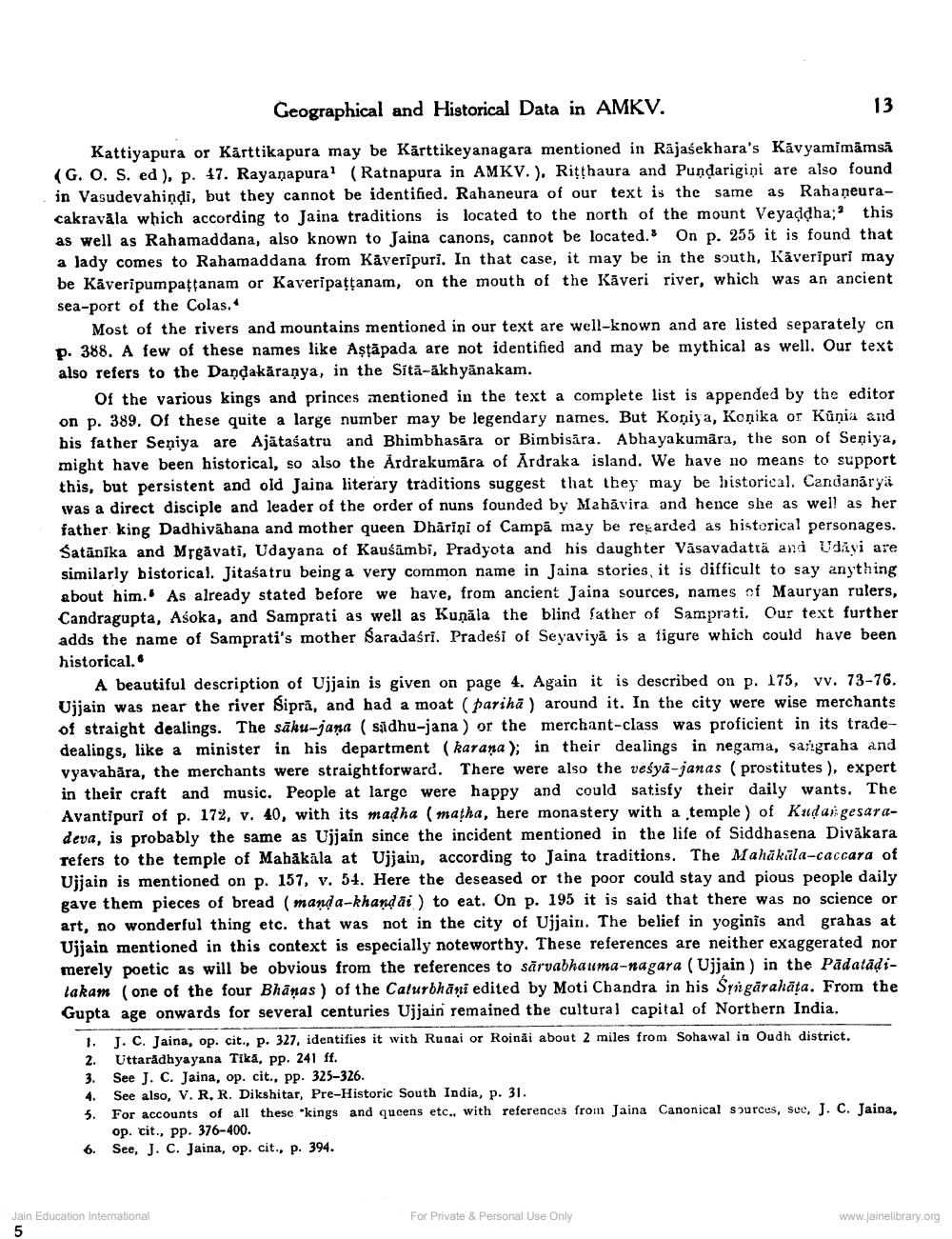________________
Geographical and Historical Data in AMKV.
13
Kattiyapura or Kärttikapura may be Kārttikeyanagara mentioned in Rājasekhara's Kávyamimāmsā (G. O. S. ed ), p. 47. Rayanapural (Ratnapura in AMKV.), Rithaura and Pundarigiņi are also found in Vasudevahindi, but they cannot be identified. Rahaneura of our text is the same as Rahaņeuracakravāla which according to Jaina traditions is located to the north of the mount Veyaddha;' this as well as Rahamaddana, also known to Jaina canons, cannot be located.' On p. 255 it is found that a lady comes to Rahamaddana from Käveripuri. In that case, it may be in the south, Kaveripuri may be Käveripumpattanam or Kaveripattanam, on the mouth of the Kaveri river, which was an ancient sea-port of the Colas.
Most of the rivers and mountains mentioned in our text are well-known and are listed separately cn 0. 388. A few of these names like Astăpada are not identified and may be mythical as well. Our text also refers to the Dandakāraṇya, in the Sita-ākhyānakam.
Of the various kings and princes mentioned in the text a complete list is appended by the editor on p. 389. Of these quite a large number may be legendary names. But Koniya, Koņika or Kūņia and his father Seņiya are Ajätaśatra and Bhimbhasāra or Bimbisāra. Abhayakumara, the son of Seniya, might have been historical, so also the Ardrakumāra of Ardraka island. We have no means to support this, but persistent and old Jaina literary traditions suggest that they may be historical. Candanarya was a direct disciple and leader of the order of nuns founded by Mahāvira and hence she as well as her father king Dadhivāhana and mother queen Dharini of Campå may be regarded as historical personages. Satānika and Mrgavati, Udayana of Kaušāmbi, Pradyota and his daughter Väsavadatta andi Udiyi are similarly historical. Jitaśatru being a very common name in Jaina stories, it is difficult to say anything about him. As already stated before we have, from ancient Jaina sources, names of Mauryan rulers, Candragupta, Asoka, and Samprati as well as Kuņāla the blind father of Samprati. Our text further adds the name of Samprati's mother Saradasri. Pradesi of Seyaviya is a figure which could have been historical.
A beautiful description of Ujjain is given on page 4. Again it is described on p. 175, vv. 73-76. Ujjain was near the river Sipră, and had a moat parihā) around it. In the city were wise merchants of straight dealings. The sāku-jana ( sådhu-jana ) or the merchant-class was proficient in its tradedealings, like a minister in his department (karana); in their dealings in negama, sarigraha and vyavahāra, the merchants were straightforward. There were also the vesya-janas prostitutes ), expert in their craft and music. People at large were happy and could satisfy their daily wants. The Avantipuri of p. 172, v. 40, with its madha (matha, here monastery with a temple) of Kudargesaradeva, is probably the same as Ujjain since the incident mentioned in the life of Siddhasena Diväkara refers to the temple of Mahakāla at Ujjain, according to Jaina traditions. The Mahāküla-caccara of Ujjain is mentioned on p. 157, v. 54. Here the deseased or the poor could stay and pious people daily gave them pieces of bread (manda-khand ai to eat. On p. 195 it is said that there was no science or art, no wonderful thing etc. that was not in the city of Ujjain. The belief in yoginis and grahas at Ujjain mentioned in this context is especially noteworthy. These references are neither exaggerated nor merely poetic as will be obvious from the references to sārvabhauma-nagara (Ujjain ) in the Padatādilakam ( one of the four Bhānas) of the Caturbhāni edited by Moti Chandra in his Srii gärahata. From the Gupta age onwards for several centuries Ujjain remained the cultural capital of Northern India.
1. J. c. Jaina, op. cit., p. 327, identifies it with Runai or Roinai about 2 miles from Sohawal in Oudh district. 2. Uttaradhyayana Tika. pp. 241 ff. 3. See J. C. Jaina, op. cit., pp. 325-326. 4. See also, V. R. R. Dikshitar, Pre-Historic South India, p. 31. 5. For accounts of all these 'kings and qucens etc., with references from Jaina Canonical sources, see, J. C. Jaina,
op. cit., pp. 376-400. 6. See, J. C. Jaina, op. cit., p. 394.
Jain Education Interational
For Private & Personal Use Only
www.jainelibrary.org




